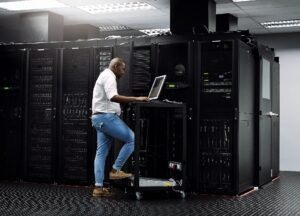A raised floor to house cabling may be the most common method of cooling data center equipment, but it’s far from the most energy efficient. Increased fan power, oversized cooling units, increased pump power and lower cooling set points are needed to offset cable blockage and air leakage problems caused by this configuration. Cable configuration Cold air forced underneath the floor cools cables can lead to hot spots, jammed plenums and reduced cooling system efficiency. In fact, cable cutouts in raised floors required to provide access to racks and PDUs contributes to a cold air leakage of 37%. Many new data centers choose instead to lay cables on hard floor and cool servers with in-row, overhead or room air conditioning with hot aisle containment. But data center owners are increasingly eyeing overhead cable trays for network data and power cabling. Not only does the system lower cooling fan and power pump consumption by 24% compared to the raised floor system – translating into significant cost savings – a modular overhead tray layout facilitates regular cable maintenance. Energy analysis Under-floor cabling wastes energy in three ways. Older, unused cables are frequently left in place to minimize downtime during installation of new network or power cables. The resulting jam of excess cables under the floor blocks air flow which makes it hard to cool servers and contributes to hot spots in the data center. Also, cutouts in floor tiles to feed cables into the bottom of racks as well as those required for PDU input conductor connections are significant sources of cold air leaks. An overhead system can contribute to energy savings by lowering fan losses and pump losses. In addition, energy cost savings can be realized when the chilled water supply temperature is increased. Creating a hypothetical 1MW data center at 100% load (i.e., assumed to house 500 IT racks at an average power density of 2kW/rack) allowed for analysis of savings in moving network and power cables to an overhead cable tray system. The results showed that leakage – caused most significantly by cable cutouts behind IT racks (33%) – was reduced from 55% to 13%. The reduction in leakage causes the computer room air handler (CRAH) return temperatures to be raised, which in turn increases the cooling capacity for each individual CRAH unit. The number of CRAH units was reduced from 42 to 31 in the test center, leading to the estimated 24% savings in fan and pump power. Efficient maintenance An overhead system also allows for easier cable maintenance by facilitating access to the slew of system cables. But even an overhead cabling system can lead to cable “spaghetti” – a mass of tangled cables that makes it impossible to find and replace “dead” cable with new cable. As a result, new cable is laid without removing the old, leaving as much as 80% of dead cables in place. Creating a modular overhead system provides a solution to this potential problem. Data center personnel can more easily sort and plan cable location, integration and removal with multi-level cable tray organization. In addition, the system facilitates the removal of a “dead” cable, since it will not be tangled or buried among a multitude of other cables. Ultimate savings In addition to realizing energy savings, data centers would also see a reduction in capital costs for CRAH units (eliminating the 11 additional CRAH units in the hypothetical analysis resulted in an estimated $90,000 savings) as well as the significant expense of a raised floor. To learn more about how you can benefit from overhead cabling, read the APC by Schneider Electric white paper, How Overhead Cabling Saves Energy in Data Centers.

